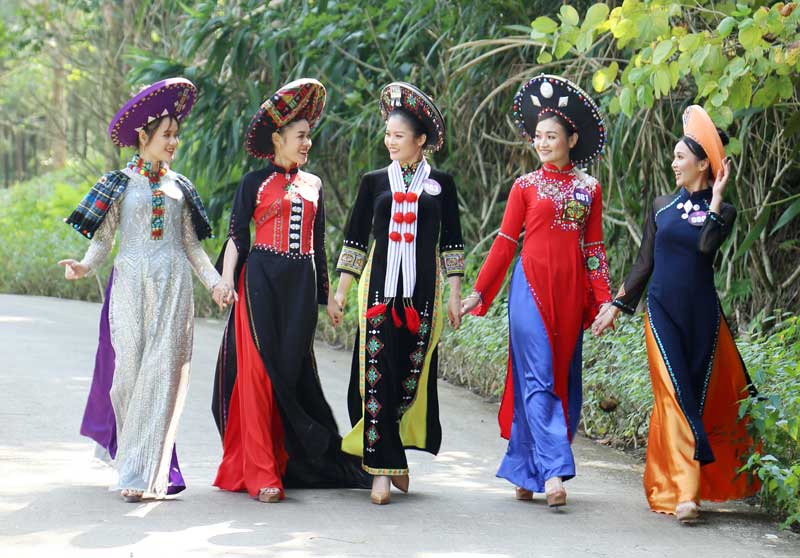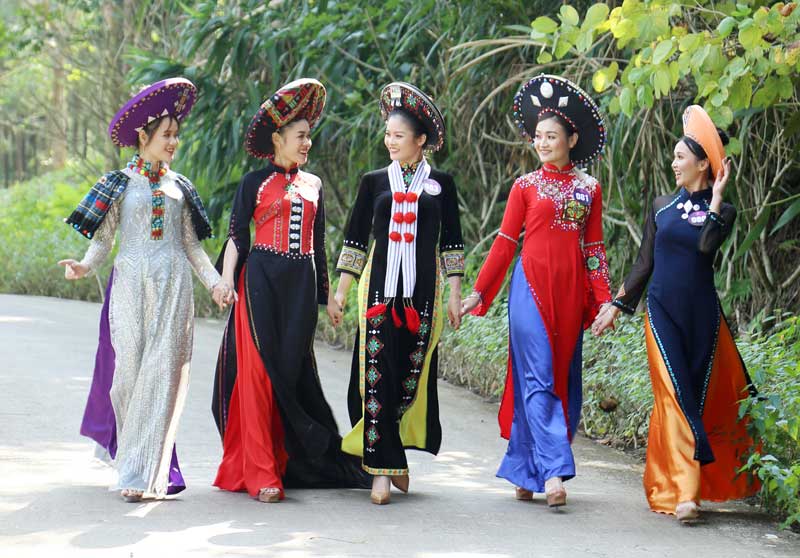
(HBO) - The Standing Committee of the Women’s Union of Hoa Binh province has issued Official Dispatch No. 1165/BTV-VP dated February 5, 2020 on response to the campaign entitled "Ao dai – Vietnamese cultural heritage” which was launched by the Central Committee of the Vietnam Women’s Union.
 Contestants of the 2019 "Beauty of Muong land” contest
wear "ao dai” (Vietnamese traditional long dress).
Contestants of the 2019 "Beauty of Muong land” contest
wear "ao dai” (Vietnamese traditional long dress).
Activities within the framework of the campaign
are slated for March 6 with all members of the women’s union at all levels and
female workers in the province wearing ao dai.
The women’s unions of districts, Hoa Binh city
and agencies were asked to join hands with media units to call on female
workers to wear "ao dai” at their workplaces, schools and offices, as well as
during social and family events.
Organisations and individuals were
requested to team up with relevant agencies to arrange practical, suitable and
creative activities such as "ao dai” shows, meetings with ao dai designers and
tailors; encourage designs with traditional materials; hold workshops and
contests; and present "ao dai” for poor women, among others.
This is part of activities to promote the
image of Vietnamese women’s "ao dai”, in a bid to have "ao dai” inscribed on
the list of national intangible cultural heritage./.
With an increasingly vibrant and widespread emulation movement aimed at building cultured residential areas and cultured families, Yen Thuy District has been making steady progress toward improving both the material and spiritual well-being of its people, while fostering a civilized, prosperous, beautiful, and progressive community.
Once lacking recreational spaces and community facilities, Residential Group 2 in Quynh Lam Ward (Hoa Binh City) has recently received attention for the construction of a new, spacious, and fully equipped cultural house. The project followed the model of state support combined with public contributions in both labor and funding.
The "All people unite to build cultural life" movement, which has been effectively integrated with Kim Boi district’s socio-economic development goals, is fostering a lively spirit of emulation across local residential areas, hamlets, villages, public agencies, and enterprises. In addition, through the initiative, traditional cultural values are being preserved and promoted, while community solidarity and mutual support in poverty reduction and economic development are being strengthened.
A working delegation of the Hoa Binh provincial People’s Committee led by its Permanent Vice Chairman Nguyen Van Toan on June 11 inspected the progress of a project to build the Mo Muong Cultural Heritage Conservation Space linked to tourism services in Hop Phong commune, Cao Phong district.
Born and growing in the heroic land of Muong Dong, Dinh Thi Kieu Dung, a resident in Bo town of Kim Boi district, in her childhood was nurtured by the sweet lullabies of her grandmother and mother. These melodies deeply imprinted on her soul, becoming an inseparable part of her love for her ethnic group's culture. For over 20 years, this love for her hometown has driven Dung to research, collect, and pass down the cultural values of the Muong people to future generations.
In the final days of May, the Ethnic Art Troupe of Hoa Binh Province organized performances to serve the people in remote, mountainous, and particularly disadvantaged areas within the province. These were not just ordinary artistic shows, but they were the meaningful journeys aimed at spreading cultural values, enhancing the spiritual life of the people and contributing to the preservation of ethnic minority cultural identities.



 Contestants of the 2019 "Beauty of Muong land” contest
wear "ao dai” (Vietnamese traditional long dress).
Contestants of the 2019 "Beauty of Muong land” contest
wear "ao dai” (Vietnamese traditional long dress).